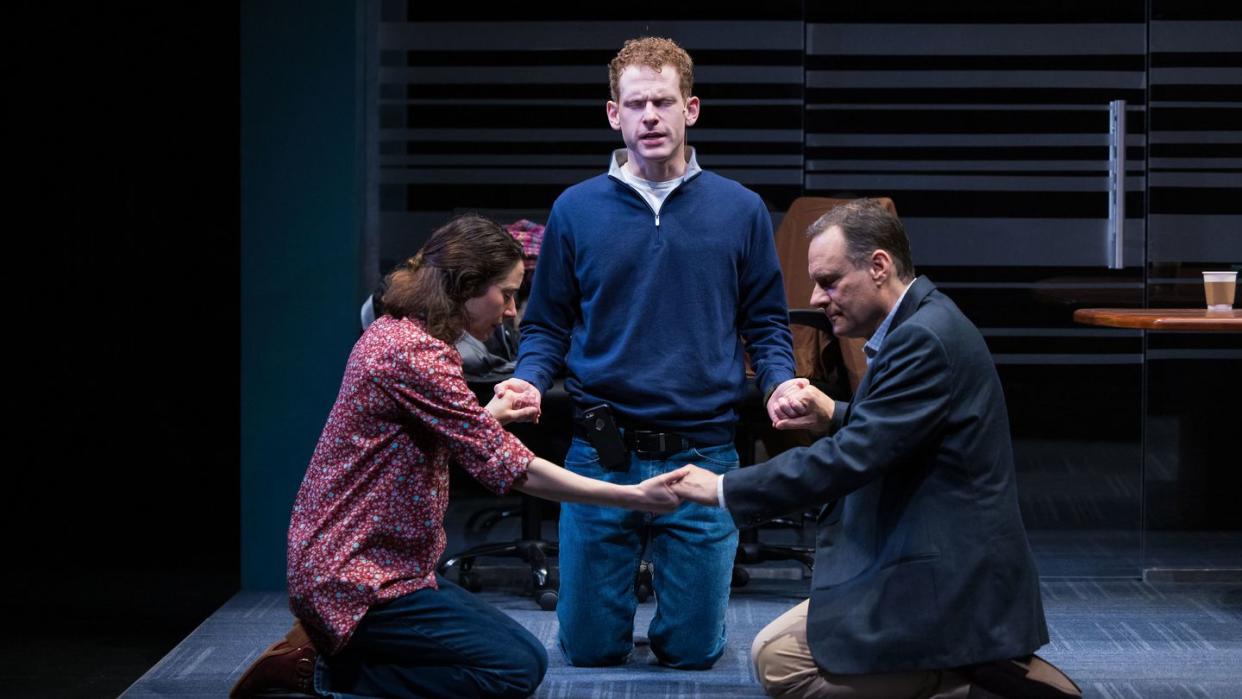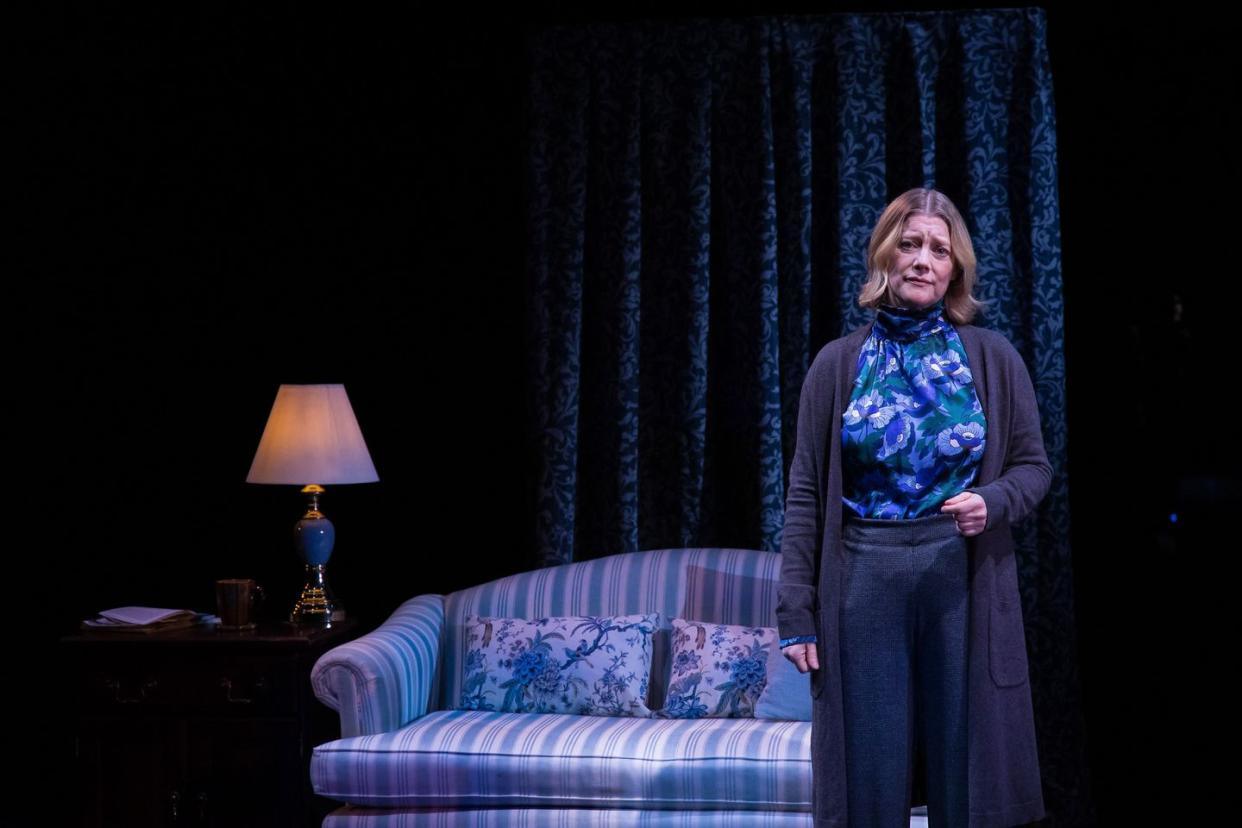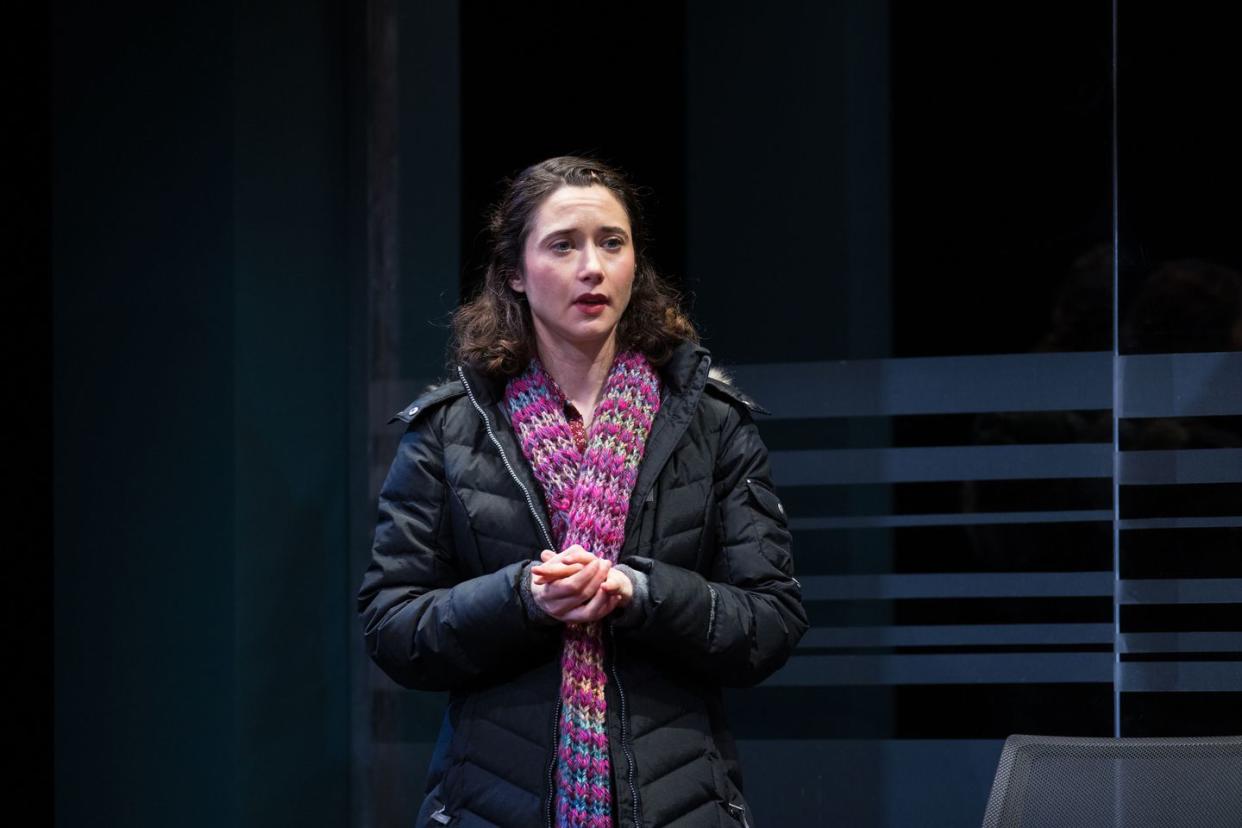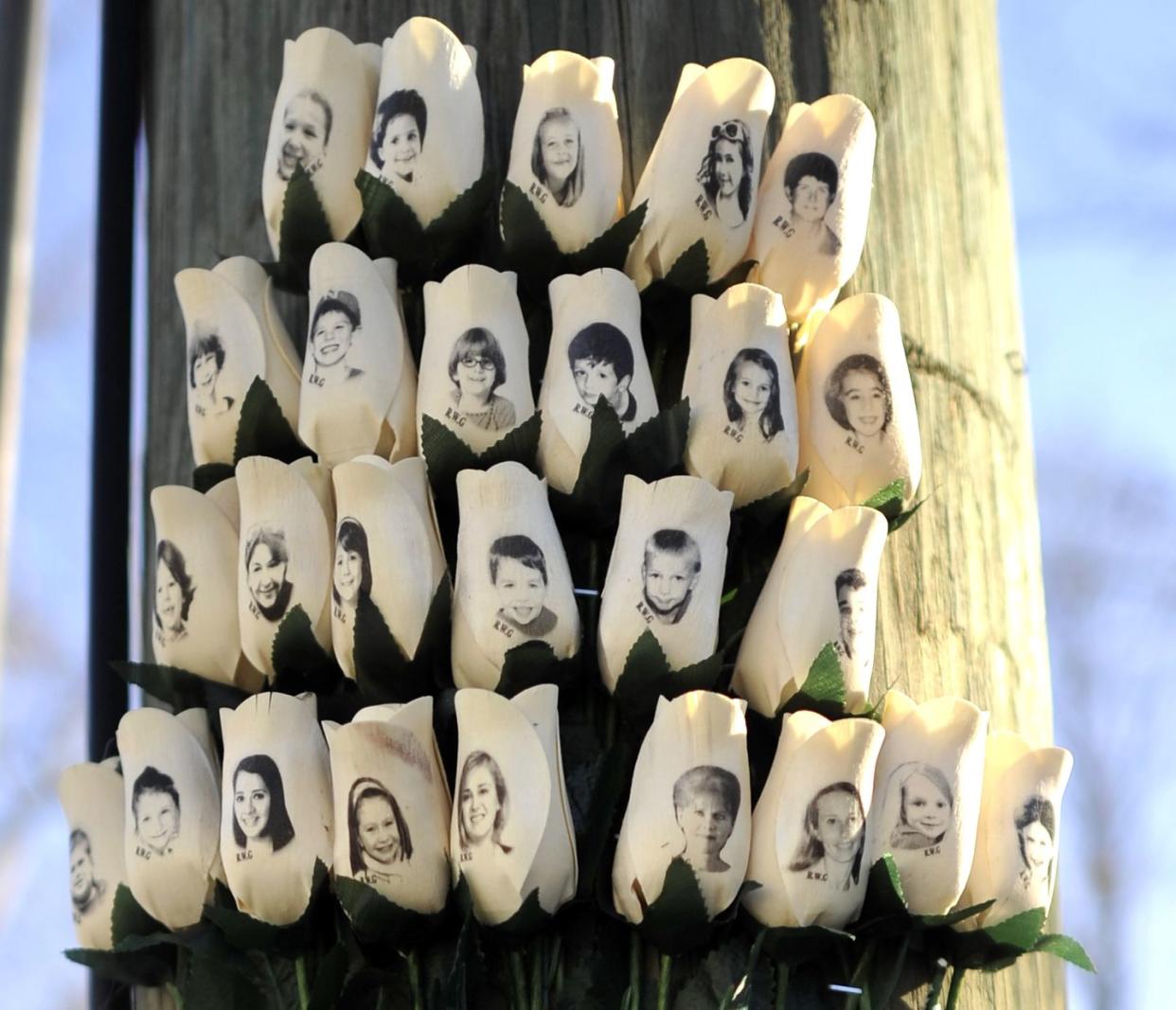The Play About a Mass Shooting You Need to See

Tonight is the first performance. A preview of a play I’ve written. I am making small talk in the lobby. Trying to take care of others, to put them at ease, when of course I am jumpy, distracted, sweating. The director steps on my foot and apologizes profusely; she’s nervous too. I crack a joke about our nearly matching leather coats: “Makes us feel protected.” The audience is milling about, sipping drinks from plastic cups, glancing at an LED screen that provides context and content warnings: “In-depth discussions about guns and gun violence…a brief mimed depiction of gun usage…themes of violence.” I am wondering if anybody affected by the 2012 shooting at Sandy Hook Elementary School in Newtown, Connecticut, will be in the audience tonight, and if so, how they will respond. Wondering: Have I done their story justice?
The usher scans my ticket. I take my seat in the last row beside the director, the dramaturg, the show’s designers, all of us with our pens and notepads ready, as we will continue to work on the play throughout the week of previews. The audience falls silent as lights fade to black. Then a slow bloom of light reveals the mother of the killer.
Ten years ago the Oregon Shakespeare Festival commissioned me to write a play about the history of guns in America. My first impulse was to look backward—this was meant to be a history play—in search of a seed, an original and defective germ in the American psyche. For a while I pondered writing a play about the first European murdered in Pilgrim Colony with a firearm: John Newcomen, a Puritan, shot with a blunderbuss by John Billington, a Stranger, or nonreligious settler. But the idea felt safe, almost cozy. Setting a play about guns in a faraway time and culture lacked the urgency the subject required. And urgency was what I felt. The true story about guns in America that was haunting me was the Sandy Hook tragedy.
Perhaps I was feeling haunted because I had newly become a father. Perhaps I was simply a human being. Twenty children, ages six and seven, along with six of their teachers, had been slaughtered by a gunman utilizing an AR-15 style semi-automatic rifle, the Bushmaster XM-15. The national epidemic of mass shootings, and of school shootings in particular, had seemed to have reached its most horrific manifestation. There are many factors that make me want to write something, but fear is key: If a subject is compelling and frightens me enough, I will probably write about it. I wanted to write my commissioned history play about Sandy Hook, but I worried that it wasn’t “history” yet. And the truth is I was probably too frightened. Could I face the months and years of research, composition, development and revision, descending into the darkness of this story? Could I find any hope and light?

Then—an interruption. In 2016 I was diagnosed with stage 4 colon cancer. After nine months of surgeries and intensive chemotherapy, I came through the fire with “no evidence of disease.” I was just learning to trust my life again when the 2018 shooting at Marjory Stoneman Douglas High School in Parkland, Florida, brought me back to Sandy Hook. I was suddenly certain that I should write this play. I wasn’t scared anymore—maybe cancer had emboldened me. I would write a “recent history” play, or a play about a calamity that was receding into history, superseded regularly by all-too-similar acts of gun violence. My intention was to remember Sandy Hook, to remind myself and remind audiences; to engage artistically with the trauma as I had attempted in the past to write about the painful memories of my abusive childhood, and the stark challenge of cancer. I hoped to write about the horror of Sandy Hook with clarity and compassion in order to grieve it, but also to plumb its darkness for meaning.
The mother of the killer spoke to me first. Spoke in my imagination, of course, because Nancy Lanza was murdered by her son in the hours before he carried out the atrocity at Sandy Hook. Her appearance on the page was ghostly, as if suspended in time, asking her son, “Why won’t you speak?”
My research had informed me that Adam Lanza hadn’t spoken to his mother in months. The character of the mother that was finding her voice in my play was, in a way, speaking for all of us, interrogating her son: Why was he behaving as he was? Who or what was responsible for his psychological dysfunction? What conditions and circumstances could be alleviated or averted so as to avoid the barely conceivable destruction that was lurching into view?
This was the shooter’s mother speaking, but she was also my mother. My mother was logorrheic, in that she spoke incessantly, often lyrically and brilliantly, and her children were her captive audience. She used language to reach us, but also to hide from us, and to hide from herself; most often her talking was deployed in the service of her denial. Her children were suffering from various mental illnesses, especially my older brother, who was depressed and had attempted suicide when he was 17. She didn’t seek treatment for my brother, even after that. She tried to help him—to heal him—in private (one might say in secrecy). Their dynamic reminded me of what I could imagine existing between Nancy and Adam: a mother with psychological troubles of her own, trying desperately to help her even more damaged son.
During these early days of composition I was reading articles and books about Sandy Hook, as well as the 1,500 pages of files released by the FBI in 2017. It was difficult to spend much time with this material. I paced myself, absorbed the information in small doses. I leaned on what I had learned from cancer: that one has to face a trauma if one hopes to transcend it. Research for this play was like exposure therapy in psychotherapy in that Sandy Hook grew less frightening the more I looked squarely at the truth of what had happened.
Then I read Alissa Parker’s memoir An Unseen Angel: A Mother’s Story of Faith, Hope, and Healing After Sandy Hook. Alissa and her husband, Robbie Parker, lost their six-year-old daughter, Emilie, in the shooting. I was profoundly moved by the eloquence, honesty, and courage of Alissa’s writing. On a single page of her book I discovered a reference to a meeting that took place between Alissa and Robbie and the father of the gunman, Peter Lanza, a mere five weeks after the shooting. Alissa wrote that she and Robbie had wanted to offer Lanza their empathy for his suffering, and to forgive him.
Intrigued is too mild a word—I was astounded. I needed to understand what their meeting had been like, how the interaction—the confrontation?—had unfolded, moment by moment. And how did it end? Was forgiveness offered and accepted? Is forgiveness possible after such a heinous crime? This would be my play’s second act, if I could manage it.
I wondered if it would be possible to write with the cooperation and perhaps the collaboration of these real people. The play might become a documentary, or a docudrama (fact-based yet slightly fictionalized). I attempted to contact Alissa several times through her publisher and charities with which she was associated, but I never heard back. Was her nonresponse a rejection, or was she simply ambivalent to my proposal? I contacted Andrew Solomon, whose 2014 New Yorker profile “The Reckoning” derives from a series of interviews with Peter Lanza, and Solomon kindly passed along my query to Lanza. I didn’t receive a response from Lanza either.

Meanwhile I was having trouble waiting for answers. My daughter was in kindergarten and for the first time in her life—in her parents’ lives too—undergoing active shooter drills. She and her classmates were rehearsing an unlikely emergency in which a coyote would break into their school: They hid in closets, beneath desks, keeping quiet—“like a game,” their teachers suggested, though my daughter sensed the dreadful seriousness of these drills. If I could not contact the Parkers and Peter Lanza and write a documentary-style drama about their meeting, then I would change their names, alter some biographical materials, and invent what might have happened. I had no idea what this would mean for the play’s future as a viable theatrical production, legally and ethically speaking. I would write the play for myself because I had to.
I still felt the need to write with as much nonfictional material as possible, worrying that a highly fictionalized rendition of Sandy Hook would be evasive: If the play wasn’t real, or real enough, would the audience be moved, and moved to act personally and politically? I chose to involve details of the Parkers’ lives, and some of their words, quoted in the news and written in Alissa’s memoir, in an attempt to fashion a play that retained the power of authenticity. But there was a limit to what was known, and could be known; crucially, I now realize, at a certain point I began to pay a little less attention to my research, so that I might more thoroughly imagine myself in the bodies and minds of real people who were becoming characters. I write “crucially” because I believe that lacking the active collaboration of the Parkers and Lanza was an opportunity for empathy: I was forced to imagine myself not as a spectator to trauma but as a participant.
Peter Lanza has never approved, or acknowledged, what I have written. As far as I know, he has not granted an interview since Solomon’s profile. But his story, and therefore his character, is history now—a history that belongs to us all. If Lanza hears about Newtown, if he reads it, I hope that he will understand the play as one writer’s attempt to understand him and his story with compassion.
I have experienced considerable anxiety in recent months, trying again to reach Alissa Parker. I had resolved not to use the Parker family’s biographical details, and sections of Alissa’s writing, without her approval. A few months ago her publisher responded that Alissa was open to a partial adaptation of the book, but that she wanted to read my script first. I sent it right away, and weeks passed. The start of rehearsals was fast approaching. I worked on an alternative draft that revised the Parkers as fictional Sandy Hook parents, and replaced any dialogue adapted from Parker’s book with fictional material. This draft was inferior, I suspected. Three weeks before rehearsals were set to begin, I received word from Alissa Parker through her publisher: “You are good to use Unseen Angel in the play.”
I had finished a solid draft in January of 2020. Plans were underway for a workshop at Oregon Shakespeare Festival when Covid-19 shut everything down. The play’s future was in limbo—the future of the American theatre was in limbo, it seemed. I didn’t know if Newtown would ever be produced. Early in 2023, Elizabeth Williamson, the new artistic director at Geva Theatre in Rochester, New York, called me. Elizabeth is one of the smartest, kindest, boldest theatre makers I know, and on that phone call a year ago, she spoke of the 2022 mass shooting at the Tops Friendly Markets in Buffalo, New York, not far from Rochester. “We have to do this play,” she said.
Our first week of rehearsal in Rochester was snowy and cold, but our meet-and-greet was the morning of the spring equinox and we felt hopeful. We spent our first days conducting table work, seated and reading the play many times, taking many pauses to question. We questioned the director, we questioned the actors, but mostly we questioned me, the playwright. Why does the character say or do this? What does she mean? What is he hoping to accomplish? What is he feeling and not comprehending? What are they struggling and failing to say?
As a playwright I shrug a lot, which I know can be aggravating. I’m not trying to be slippery. Many of their questions improved the script; I rewrote in rehearsal, or after hours. But questions about character are often best left unanswered. Fully realized characters have a flexibility concerning their interior lives and their commensurate behavior; the choices that actors make for themselves are usually more effective than anything a playwright could suggest. I’m not the one who has to stand onstage and speak these lines and embody these conflicts. My work is (almost) done. Rehearsal is when a playwright lets go, transferring the play to the artists who will transform the words on the page into a three-dimensional, present-tense, volatile occurrence for the audience to experience—ideally as an iteration of their own lives. In rehearsal the play is handed over to the performers and the production team, and soon it will be handed to the audience.
The actors, all based in New York City, had been researching much of the same material that informed the writing of the play. They arrived at rehearsal each day moved and disturbed by the reality of what we were endeavoring to depict onstage. Their anguish reawakened mine. I reassured them—though likely they didn’t need my reassurance—that they would, to a degree, acclimatize to the intensity of this play. They would find what I had found: that confronting the reality of Sandy Hook, salvaging some measure of meaning from the devastation, is a consolation, a privilege and a responsibility of survivorship, and a fate far preferable to persisting in the darkness of denial.

Denial came up in rehearsal with Kellie Overbey, the actor who portrays the mother of the shooter. Overbey’s character, now named Sarah, speaks in conflict with her unspeaking son, but also in conflict with herself. Like my mother long ago trying to reach my brother as he suffered in his withdrawn and severe depression, Sarah is fighting the tide of her desperate need to deny the bleakness of her predicament. Her denial is her defense; she cannot allow herself the realization that the choices she has made, or the choices that she has not made, may have exacerbated the situation in which she finds herself. She cannot accept that her collection of firearms, and the hobby she shared with her son of frequenting gun ranges, has become the critical element in an impending catastrophe.
Near the end of her monologue Sarah wonders if the seed of American violence was carried across the Atlantic on the Mayflower. She conjures a scene for her son—a scene from history that I encountered early in my research, of sickly and weary settlers splashing down into the shallow bay to wade the remaining half-mile through the receding tide toward the shore. What has lingered with me is the image of men and women and children struggling toward at least temporary safety, two steps forward in the receding waves and one step back in the undertow and sucking mud.
“Toward and away. Toward and away,” says Sarah, subtly pantomiming for her son the arduous progress of history.
Overbey discussed this image one afternoon in rehearsal in terms of her character’s arduous attempt to reach her son and save him from his fate. This is a wonderful interpretation of the metaphor. Any good metaphor means many things. But this is my interpretation: We are struggling as a society toward the shore of a sensible solution to the reality of gun violence, fighting the undertow of denial and less forgivable obstacles.
Toward and away.
Toward and away.
The first public performance of the first act is almost over. Sarah is speaking: “Toward and away.” Her portrayal has grown in rehearsal; this section of the monologue has become an almost incantatory series of gestures, as Sarah reaches her arms toward the audience, swaying her body back and forth. She is somewhere else in time and place. But the spell dissipates; her eyes open. She asks her son to “tell me what I’m not seeing” about his problems, about his deadly plans. The confusion that contorts her face is heartbreaking. Again, her son won’t answer. “Because I have looked everywhere at everything, like causes and circumstances, and still I cannot comprehend.” She is lost in denial. She is tired; she’s going to bed. “I’ll be sleeping in my room,” she says, “and when I wake up we’ll know what to do.”
She exits. In a rushing rise of light and sound and archival news clips we learn that Sarah has been killed, the school shooting has taken place. And as the storm subsides the stage transforms into a corporate conference room. Two people sit silently praying: the parents of a child killed at Sandy Hook, awaiting the arrival of the father of the killer. In act two it will be their task, as it is ours in the aftermath of every mass shooting, to comprehend, and to figure out what to do.
You Might Also Like
